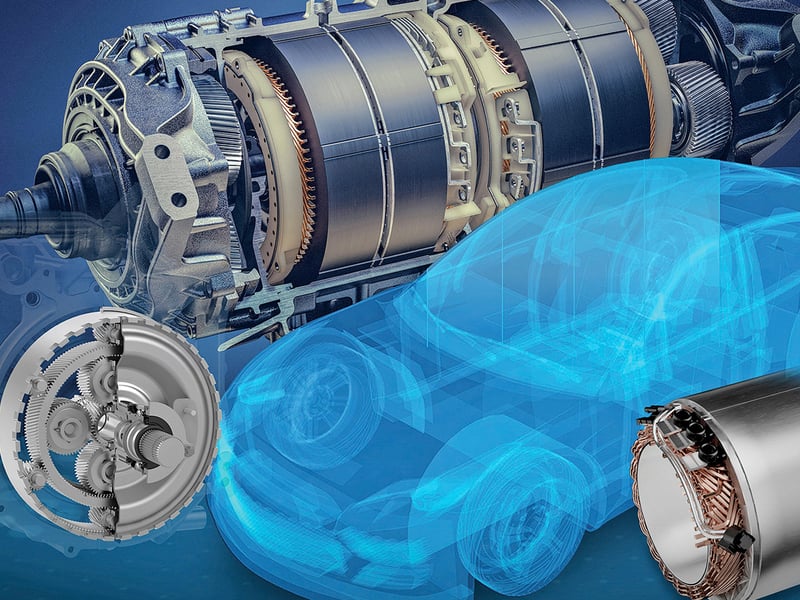Electric motors (e-motors) play a vital role in the electric vehicle (EV) powertrain, transforming electrical energy from batteries and inverters into mechanical energy for propulsion. As global adoption of EVs continues to rise, the market for e-motors is projected to grow significantly, expanding from $24 billion in 2024 to $74 billion by 2032, according to Fortune Business Insights.
The e-motor segment has not yet settled on a single design or class. Radial flux motors, characterized by coils arranged cylindrically with a magnetic field perpendicular to the shaft, are among the most common designs. However, the automotive industry’s quest for increased torque and power density has led to interest in axial flux motors, which have coils arranged more flatly and a magnetic field parallel to the shaft. This design tends to be more efficient and less cumbersome. In 2021, Mercedes-Benz made a strategic acquisition of Yasa, an axial flux e-motor manufacturer, to explore the potential of this technology.
Other manufacturers, such as BMW, continue to invest in radial flux motors while enhancing their performance. In 2021, BMW partnered with the Munich-based startup DeepDrive to develop new technologies aimed at improving power and range with this design. In July 2024, DeepDrive’s e-motor solution was launched on the market.
Although axial flux motors offer several advantages, they are challenging and costly to manufacture for large-scale automotive applications. This complexity makes the simpler design of radial flux motors a more practical option for meeting electrification goals. The rotor specifications of an e-motor can significantly impact its overall performance. Traditionally, radial flux e-motors feature a single rotor that rotates within a stator equipped with copper windings, which create a magnetic field to induce rotor movement. DeepDrive has innovated by incorporating two rotors—internal and external to the stator—driving them simultaneously. This dual rotor design enhances the utilization of active materials, resulting in higher torque and energy efficiency while remaining cost-effective for mass production.
DeepDrive claims to be the first to merge the benefits of radial and axial flux motors in a single product line, offering various models, including the RM 1800 for mid-size EVs, delivering 1,800 Nm of torque and 160 kW of power, and the RM 300 for micromobility vehicles, which offers 300 Nm and 18 kW. This design reportedly achieves a 20% increase in efficiency and range compared to a single rotor motor, a claim that has been validated by OEMs in real-world testing. The units are compact and lightweight, making them suitable for both in-wheel and central drive systems.
Despite its seemingly straightforward dual rotor design, significant engineering challenges needed to be addressed, including cooling, torque transfer, power electronics, and motor control. DeepDrive’s patented solution incorporates a novel stator design with specialized copper windings, as well as hardware and software to control the operation of both rotors. In April 2024, this innovative concept received a German Innovation Award from the Federal Ministry for Economic Affairs and Climate.
While some major OEMs have yet to develop their own solutions, the production of e-motors is still in its early stages, only a few generations deep. As other aspects of the EV transition require more immediate focus, opportunities remain for smaller innovators to fill gaps in the market. The e-motor field necessitates a cross-disciplinary approach, combining expertise from electrical and mechanical engineers, designers, and software developers. DeepDrive has brought together a team of specialists who can take risks that larger companies may not.
Currently, DeepDrive anticipates initiating small-series production by 2026/27, with plans for large-series production of hundreds of thousands of vehicles to follow shortly after in 2028.
As EV growth faces challenges, many automakers are looking to reduce costs while maintaining their investments in electrification. For larger players, this often means adjusting timelines for phasing out internal combustion engine product lines until EV production becomes more affordable. The mass producibility of DeepDrive’s dual rotor motor represents a significant advancement toward this goal.
The quest for e-motor efficiency at a low cost and in mass-producible quantities is critical, particularly as automakers face increasing pressure. Consumers are also seeking solutions to range anxiety and lower EV prices. A more efficient motor can allow for smaller, more affordable batteries that still provide the same range. Ultimately, the drive for powertrain efficiency is key to integrating EVs into the mainstream market.
Collaboration between established automakers and startups will be crucial for achieving these objectives. In a statement about its partnership with DeepDrive, BMW highlighted the startup’s “exciting vision for the electric drive of the future” and the valuable insights it brings. The future of successful companies in this space will likely be characterized by innovative startups supported by OEMs, creating a cooperative rather than competitive dynamic in the industry.


